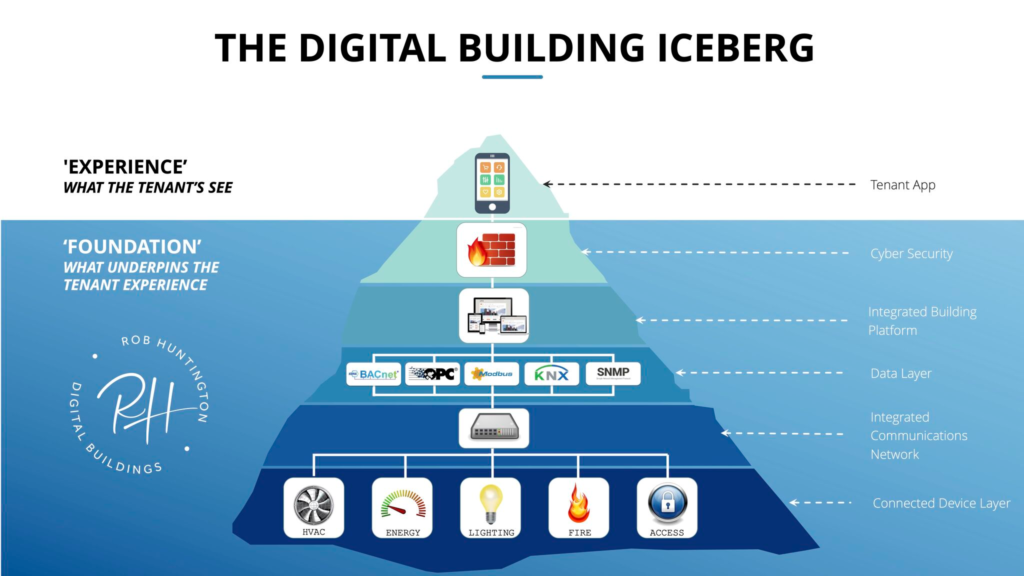
This diagram of the smart building tech stack is by Rob Huntington at emeseye (prounounced MSI, i.e. Master Systems Integrator). That gives an idea of where Rob is coming from. It is akin to the one from James Dice and his Nexus Labs community I shared earlier (see here), but is slightly more vertical and includes cybersecurity is another layer/important consideration. It also helps better explain what is going on in the data layer and what’s needed given all the different protocols being used – particularly by all the Operational Technology at the Connected Device Layer.
But Rob is really trying to do with his diagram is show that there is more to digital buildings than the tenant app, which for some have become synonymous with smart buildings. And how tenant apps represents just the more visible part of what is going on under the surface technology-wise, i.e. in order to enable the user functionality of the tenant app.
I mentioned earlier that WiredScore‘s SmartScore rating is not without it’s critics (see here). Inadvertently, the user-centric way they define smart buildings could also be seen as being part of the problem and particularly the way their framework is based around the technological foundation of smart buildings delivering user functionality:
A smart building is one that delivers outstanding outcomes for all users, through digital technology, to exceed their evolving expectations.
Smart buildings. Our future is smart. SmartScore white paper. April 2021.
Rob’s diagram could be seen representing how the technological foundation of smart buildings delivers user functionality vertically as a stack. I found it very useful but not sure it quite captures the direction of travel of smart buildings post-pandemic, i.e. the blurring of lines between smart buildings and smart offices? As I have mentioned previously, there is a difference between Efficient and Effective buildings, because however efficient technology makes a building if it is not occupied then it is neither effective nor sustainable.
That said, there’s no doubt that MSI’s like Rob from down under have a lot to offer and not least because they are further ahead than most when it comes to NABERS compliance, i.e “the system that rates the energy performance of buildings in Australia and helps users to find, estimate and compare buildings.” That experience of NABERS compliance is also likely to be a competitive advantage for those platforms that likes of Rob deploy/integrate.
However, that NABERS compliance represents the Efficiency side, whereas likes of the International WELL Building Institute‘s (IWBI) WELL rating and Leesman‘s Employee Engagement Index seem to represent the Effectiveness one. And what I noticed at the recent IWBI Regional Summit in London where Leesman presented their research there was little discussion about technology, it was far more people-centric. That is interesting because Leesman were acquired by tenant experience app HqO (see here), which could be seen as representing what I am talking about with regard to the direction of travel of smart buildings above. Given the occupancy challenges driving the Effectiveness side that blurring of lines could also include ‘smart residential’ and ‘smart retail’ as buildings increasingly become mixed use.



